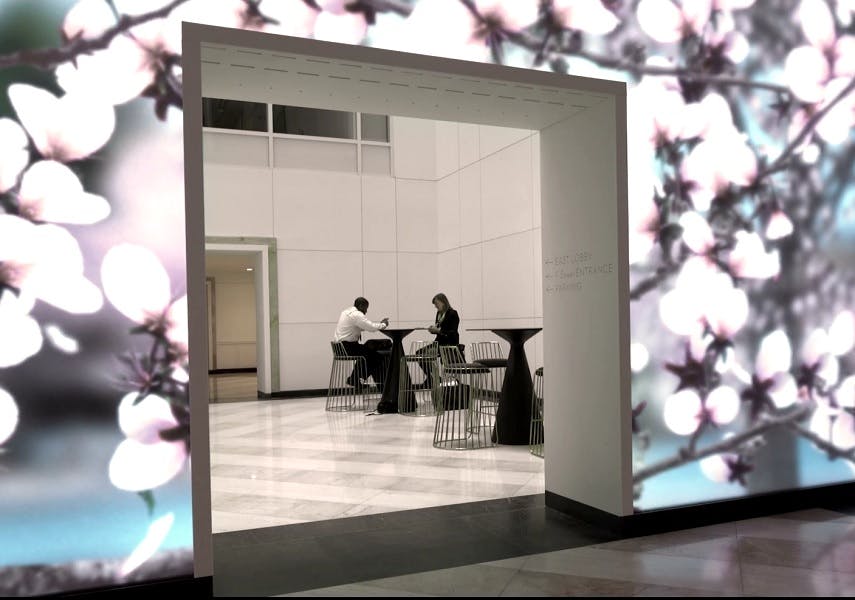It’s no secret that great workplace design can inspire your team and boost productivity. From layouts, to décor, to design elements, the contours of your space can play a pivotal role in creating an atmosphere of positivity and productivity.
The potential benefits of strategic and engaging workplace design are so significant, that an entirely new category of office architecture and design is emerging: Experiential Design. Experiential design is the art of creating impressionable moments that allow people to live and experience your brand and culture.
These moments carry through and are experienced not only in the physical work environment, but also at events, in presentations, and through printed or emailed collateral. Well-executed experiential design elements provide a stream of opportunities to make an impression, tell a story, and to exert consistency over the brand narrative that is shared both internally, and with clients and professional partners. That abstract process has a concrete payoff, with office spaces reinforcing everything from messaging and employee enthusiasm, to hiring and retention.
Dynamic and headline-worthy examples of experiential design are regularly cited, with brands like Google and LinkedIn creating high-profile signature features. Unsurprisingly, tech companies have been enthusiastic and effective in pushing the envelope in this space, adding digital design walls and interactive elements with touchscreens, cameras and other engaging elements. However, not every company has the resources to invest in the spectacular. The good news is that you don’t have to break the bank to benefit from experiential design. The right guidance and a few thoughtfully chosen design elements can make a game-changing different for a relatively modest investment.
Here are some tips and best practices for how to ensure your experiential design dollars are spent effectively to maximize the impact of your design decisions:
HR has a role
Translating who you are as an organization into where you are in terms of the physical environment you operate in on a daily basis isn’t always as easy as it seems. That’s why it is essential that HR personnel are a part of the design and implementation process. HR professionals are the heartbeat of organizations, on the front lines they absorb the great, good, bad and ugly on a daily basis. They are not only keenly aware of employees’ personal and professional priorities, they are also the first to know what criteria prospective employees are looking for (and, on the flip side, what isn’t working and is contributing to departures from valued staff). With input and insight from HR staff, companies can craft an experiential design strategy that is optimized to equip their organizations with a strategic tool for retention and talent acquisition.
Reinforce your brand
Successful businesses recognize the value in delivering a consistent brand experience. From brochures and branded swag, to professional presentations and client engagement events, reinforcing who you are is critical to building and maintaining a pivotal sense of unity and camaraderie. Paint color choices, displays and décor are also great ways to consider the connection of your space to your company’s brand identity. With those details in mind, it’s easier to curate your design decisions accordingly.
Tell your story
Historical timelines, wall art, photography, and displays that tell the company story offer an opportunity for employees to become educated about the origins and legacy of your organization. The more they learn about your past, the more invested they become in the future. That sense of place and permanence — that they are a part of something larger than themselves — is part of the benefit. Historical displays also equip your team with meaningful information they can utilize in conversations when hosting guests in your office space.
Small steps
A great way to benefit from low-cost, high-impact design is to use wall-coverings. The walls of your space are a blank canvas, and there is no better opportunity to illustrate a story that tells others about your company in ways words cannot than by making good use of that canvas. Wall coverings are an excellent way to make a dramatic impact for a relatively low investment. They come with the added benefit of flexibility, allowing you to adapt your decor as needed without making expensive changes. Research shows that people remember 10% of what they hear and 60% of what they see. The best experiential design is visually dynamic and designed to be memorable. People are going to have an impression of your space, and, with experiential design, you have control over what that impression will be.
Be intentional and strategic
Experiential designers can help clients achieve a well-rounded brand experience. Those professionals should begin by collaborating closely with client team members who are most involved in the company culture. Company values, brand, messaging, goals, priorities and expectations should all be on the table. These collaborations form the design foundation and intent. They are critical to curating a strategy and design vision that conveys an accurate, on-brand experience.
Finally, experiential design is fundamentally a powerful tool for strengthening your professional culture. It’s not about how your space looks, it’s about how it feels. If you can execute high quality touchpoints that emphasize brand consistency, fuel engagement, and deliver information in an easily digestible way, you’ll curate impressions of your brand and culture in a more holistic way. It’s no surprise that the best office cultures exist in companies where HR professionals and cultural influencers understand and appreciate the immense value of experiential design.
When your employees and guests live and feel your culture and message through their immersive interaction with your brand, they not only understand it themselves, they are more confident in sharing it with others.
